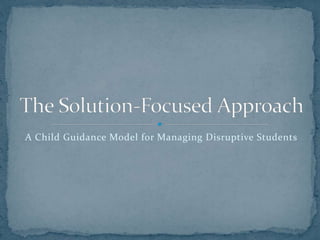
The Solution-Focused Approach
- 1. A Child Guidance Model for Managing Disruptive Students
- 2. The solution-focused model shows teachers how approaching disruptive classroom behavior differently can improve both students’ behaviors and the overall classroom atmosphere. This child guidance model looks at the habitually disruptive student’s competencies or strengths for solutions, avoiding focusing on the child’s behavior deficits, and letting the child’s competencies guide the teacher in finding solutions. According to Metcalf (1999), when teachers focus on children’s strengths, we change the context from failure (problem- focused) to hopefulness (solution-focused).
- 3. The main solution-focused technique is to observe the times when the habitually disruptive child exhibited competency of some sort; that is, identifying when in the past the child responded effectively in the classroom, and then to relay those times to the child in a caring and curious way. Simply put, we look forward for what is working with this particular child, and we make the child aware of it. In the solution-focused model, we call this technique exceptions, or the times when the child is not engaged in negative behavior and the problem is not happening. For example, for a student who has difficulty staying on task, we look for those times when the child completed tasks successfully; for a child who exhibits recurrent tantrum episodes, we identify those occasions in which she was tantrum free. According to Metcalf, noticing those exceptions gives the teacher clues to use as they, exceptions, help teachers develop a different context that is more successful for the child.
- 4. When teachers examine those exceptions, says Metcalf, we can identify the strategies we used that worked occasionally. Exceptions allow teachers to answer questions such as, “What can I do differently with this child just for today?” In addition, “How can I react differently so that my relationship with this child runs smoothly?” Metcalf recommends that the teacher writes down what he or she tried with the child, going into detail about what worked, and erasing the strategies that we used before that did not work. To change negative and habitually disruptive classroom behavior then, the clues are in the child’s successes. The solution-focused model answers mainly two questions: A. What is that the child did at the time that makes a difference? B. What is that the teacher did that makes a difference?
- 5. The solution-oriented teacher focuses on what is obvious: that the habitually disruptive and acting-out student had succeeded before. To find solutions, the teacher asks the child questions like: A. What did you do then that helped you _____ (e.g., stay on task or remain calm)? B. What did we do in class that helped you _____? Commenting, “I wonder if that would help now;” all this delivered to the student in an atmosphere of exploration and discovery. Through this kind of questioning, the teacher gives the child key information that makes the student aware of his earlier successes.
- 6. Metcalf (1999) lists a set of guiding principles for implementing a solution-focused model with students that exhibit habitually disruptive classroom behaviors. Talk about disruptive, non-compliant, and acting-out children with a no pathological approach. Describe the child’s difficulties in a more positive way to make the student’s behavior problems solvable. Change the description of the behavior problem so that you can design new strategies based on this new, no-pathological and solution-oriented definition. Do not worry about trying to figure out why a child is having a behavior problem. See habitually disruptive, non-compliant and acting-out children as students who are “stuck” in a problem but are not the problem. This will make it easier for the child to “escape” from the problem.
- 7. When the student exhibits recurrent disruptive behavior in the classroom, ask the child what she wants to be different in the classroom. In addition, ask the child what she thinks she can do differently, and what the child thinks you can do differently. Teachers know that, when a lesson plan works, we do it again, but when a lesson plan does not work, we do not use it again. We can apply the same principle in managing disruptive behaviors; in other words, stop repeating a strategy or technique that is not working, do something different. Always focus on the possible and changeable when dealing with habitually disruptive and non-compliant students. Go slowly to build successes. Think of making a slight change, not a big one.
- 8. Always watch for exceptions to behavior difficulties. Notice what you are doing that is helping the exceptions to happen; also notice what the child is doing to make exceptions happen.
- 9. Metcalf, L. (1999). Teaching toward solutions. West Nyack, NY: Center for Applied Research.
- 10. OUR FACEBOOK PAGES AND GROUPS PSYCHOEDUCATION FOR TEACHERS (Page) https://www.facebook.com/psyc hoeducationalteacher FREE OR CHEAP TEACHING RESOURCES (Page) https://www.facebook.com/freer esourcesforteachers/ WE TEACH THE WORLD (Group) https://facebook.com/groups/22 2247571474300 BOOKS IN CHILD GUIDANCE THE PSYCHOEDUCATIONAL TEACHER https://www.amazon.com/autho r/thepsychoeducationalteacher/